
A shrub is a small-to-medium-sized perennial woody plant. Unlike herbaceous plants, shrubs have persistent woody stems above the ground. Shrubs can be either deciduous or evergreen. They are distinguished from trees by their multiple stems and shorter height, less than 6–10 m (20–33 ft) tall. Small shrubs, less than 2 m (6.6 ft) tall are sometimes termed as subshrubs. Many botanical groups have species that are shrubs, and others that are trees and herbaceous plants instead.

Hazels are plants of the genus Corylus of deciduous trees and large shrubs native to the temperate Northern Hemisphere. The genus is usually placed in the birch family Betulaceae, though some botanists split the hazels into a separate family Corylaceae. The fruit of the hazel is the hazelnut.

Prunus laurocerasus, also known as cherry laurel, common laurel and sometimes English laurel in North America, is an evergreen species of cherry (Prunus), native to regions bordering the Black Sea in southwestern Asia and southeastern Europe, from Albania and Bulgaria east through Turkey to the Caucasus Mountains and northern Iran.

The loquat is a large evergreen shrub or tree grown commercially for its orange fruit and for its leaves, which are used to make herbal tea. It is also cultivated as an ornamental plant.

Acacia saligna, commonly known by various names including coojong, golden wreath wattle, orange wattle, blue-leafed wattle, Western Australian golden wattle, and, in Africa, Port Jackson willow, is a small tree in the family Fabaceae. Native to Australia, it is widely distributed throughout the south west corner of Western Australia, extending north as far as the Murchison River, and east to Israelite Bay. The Noongar peoples know the tree as Cujong.

Cotoneaster franchetii is a species of Cotoneaster native to southwestern China, in the provinces of Guizhou, Sichuan, Tibet, and Yunnan, and also in adjacent northern Myanmar and northern Thailand.

Lallemantia is a genus of flowering plants in the family Lamiaceae. It is named after the German botanist Julius Léopold Eduard Avé-Lallemant.

Roemeria argemone is a species of flowering plant in the poppy family Papaveraceae. Its common names include long pricklyhead poppy, prickly poppy and pale poppy. Its native range includes parts of Eurasia and North Africa, but it can be found growing wild in parts of North America, where it is an introduced species. It is cultivated as an ornamental plant.

Cotoneaster integerrimus, the common cotoneaster, is a species of Cotoneaster native to central and eastern Europe and southwest Asia, from southern Belgium and eastern France south to Italy, and east through Germany to the Balkans, northern Turkey, the Crimea, the Caucasus and northern Iran; plants in Spain may also belong in this species. In the past, it was treated in a wider sense, including plants from Wales now split off as Cotoneaster cambricus and plants from Scandinavia now treated as Cotoneaster scandinavicus, but differs from these in genetic profile and detail of foliage and fruit.

Cotoneaster pannosus is a species of Cotoneaster known by the common name silverleaf cotoneaster. This woody shrub is native to south central China but it has been introduced to other areas of the world, including southern Africa and Australia as an ornamental. It has become naturalized in some areas but it is a troublesome noxious weed in others, for example, in Hawaii. This is a sprawling shrub easily reaching over 3 meters in height. It is covered in dull green oval-shaped leaves with fuzzy white undersides and blooms in white flowers. The fruits are red-orange pomes containing two seeds each. These fruits are very attractive to birds, which are the main agent of seed dispersal. It grows on the elevation of 3,280 feet (1,000 m).

Asphodeline is a genus of perennial plants in the family Asphodelaceae, first described as a genus in 1830. It is native to the eastern Mediterranean region and the Middle East from Italy and Algeria east to Iran.

Lake Nemrut is a freshwater crater lake in Bitlis Province, eastern Turkey. It is part of Nemrut Caldera, a volcanic caldera atop Volcano Nemrut.
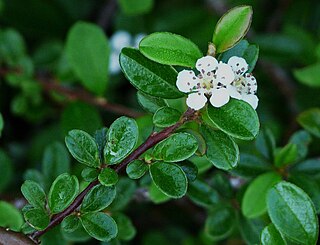
Cotoneaster dammeri, the bearberry cotoneaster, is a species of flowering plant in the genus Cotoneaster, belonging to the family Rosaceae, native to central and southern China and naturalized in Europe.
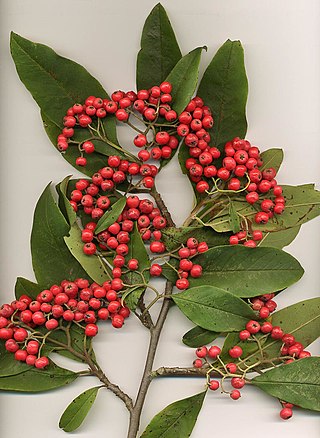
Cotoneaster frigidus, the tree cotoneaster, is a species of flowering plant in the genus Cotoneaster of the family Rosaceae, native to the Himalayas. It is a deciduous tree or shrub growing to 10 metres (33 ft). White flowers are followed by masses of small, globose, red fruits (pomes) in autumn, persisting into winter if not eaten by birds.

Hakea leucoptera, commonly known as silver needlewood, needle hakea, pin bush or water tree and as booldoobah in the Koori language, is a shrub or small tree with rigid, cylindrical, sharply pointed leaves and white, cream-coloured or yellow flowers in late spring and early summer. It is widespread and common in central parts of the Australian mainland.
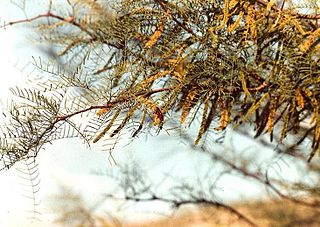
Prosopis chilensis is a species of tree in the genus Prosopis, belonging to the family Fabaceae. It is found in parts of central Chile, southern Peru, Bolivia, and Andean (northwestern) Argentina. Its common names include Chilean mesquite, cupesí, and Chilean algarrobo. It is used for providing shade, for animal feed and for firewood.
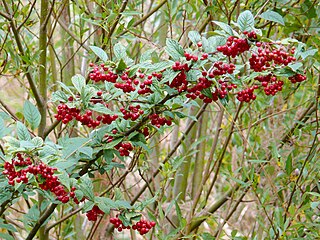
Cotoneaster bullatus, the hollyberry cotoneaster, is a species of shrub in the genus Cotoneaster within the rose family. Its natural range is in Western China, where it is found in a range of woodland and shrub biotopes from 900 to 3200 m above sea level.

Corokia cotoneaster is a flowering plant in the family Argophyllaceae was described by Étienne Fiacre Louis Raoul in 1846. This plant is commonly known as the wire-netting bush, korokio, or korokia-tarango. The word "Koriko" comes from the Māori language.
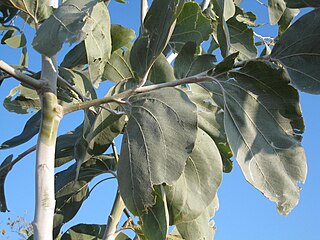
Acacia dunnii, commonly known as elephant ear wattle or Dunn's wattle, is a shrub or tree of the genus Acacia and the subgenus Plurinerves.

Uapaca bojeri, or tapia, is a tree species endemic to Madagascar. A characteristic element of the Madagascan flora, it occurs in the central highlands, where it dominates a type of sclerophyllous forest or woodland. Tapia forest has a high ecological value due to the fauna, flora, and funga it harbours, and is of economic interest to the local population, e.g. for collection of tapia fruits, firewood, mushrooms or wild silkworms, and hunting. Local impact through fire and cutting is seen as a form of sustainable use however tapia woodlands are now found only in scattered, isolated stands totaling at most 132,255 ha. Native woody vegetation of the central highlands is increasingly replaced by grasslands, primarily due to increased fire frequency as areas are burned annually.




















